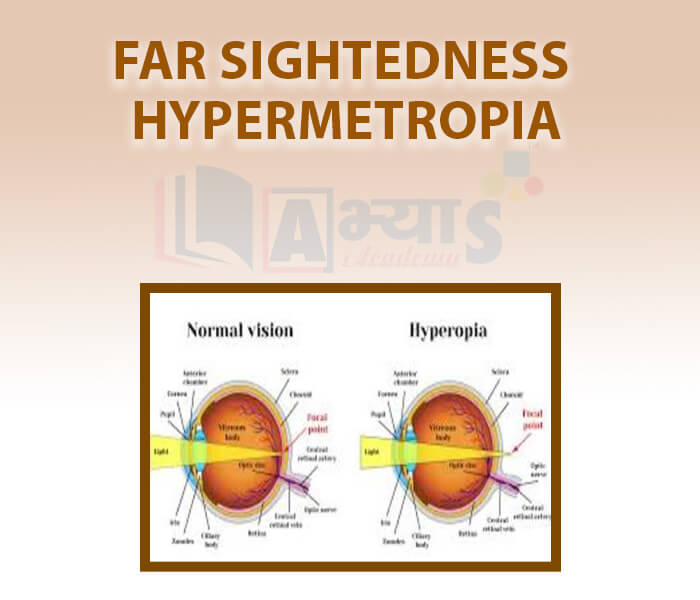Far Sightedness Hypermetropia







Far Sightedness Hypermetropia
Far-sightedness (Hypermetropia): Some people cannot see nearby objects clearly, although they can see distant objects clearly. This defect is called far-sightedness, long- sightedness, hypermetropia or hyperopia. It arises mainly due to two reason
People suffering from far-sightedness have difficulty in reading a book or a newspaper, or viewing a small object placed close to the normal near point, N (at 25 cm). People suffering from far-sightedness have to keep reading material or an object much farther away to see clearly. In other words, their near point, N', is farther than the normal near point, N Correcting far-sightedness: To see an object placed at the normal near point, N, clearly, its sharp image should be formed on the retina. For this, the rays should seem to be coming from N', the near point of the defective eye. To do this, the rays are made less divergent by placing a convex lens in front of the eye as in figure (c). Rays of light coming from N pass through the convex lens. When produced backwards, the emergent rays meet at the point N'. Thus, a sharp image is formed on the retina.
|
|
Far sightedness is also known as _____________________. | |||
| Right Option : D | |||
| View Explanation | |||
Which of the following are the reason of farsightedness : (a) The eyeball becomes shorter than the normal. As a result, the distance of the retina from the crystalline lens decreases. (b) The eyeball becomes wider than the normal. As a result, the distance of the retina from the crystalline lens decreases. (c) If the eye-lens has a focal length that is larger than the normal due to abnormal curvatures of the cornea. (d) if the eye-lens has a focal length that is smaller than the normal due to abnormal curvatures of the cornea. | |||
| Right Option : C | |||
| View Explanation | |||
___________ is used to correct far sightedness. | |||
| Right Option : A | |||
| View Explanation | |||
Students / Parents Reviews [10]
A marvelous experience with Abhyas. I am glad to share that my ward has achieved more than enough at the Ambala ABHYAS centre. Years have passed on and more and more he has gained. May the centre flourish and develop day by day by the grace of God.

Archit Segal
7thMy experience with Abhyas is very good. I have learnt many things here like vedic maths and reasoning also. Teachers here first take our doubts and then there are assignments to verify our weak points.

Shivam Rana
7thIt was a good experience with Abhyas Academy. I even faced problems in starting but slowly and steadily overcomed. Especially reasoning classes helped me a lot.

Cheshta
10thIt has a great methodology. Students here can get analysis to their test quickly.We can learn easily through PPTs and the testing methods are good. We know that where we have to practice

Barkha Arora
10thMy experience with Abhyas academy is very good. I did not think that my every subject coming here will be so strong. The main thing is that the online tests had made me learn here more things.

Hiya Gupta
8thAbhyas Methodology is very good. It is based on according to student and each child manages accordingly to its properly. Methodology has improved the abilities of students to shine them in future.

Manish Kumar
10thMy experience was very good with Abhyas academy. I am studying here from 6th class and I am satisfied by its results in my life. I improved a lot here ahead of school syllabus.

Ayan Ghosh
8thAbout Abhyas metholodology the teachers are very nice and hardworking toward students.The Centre Head Mrs Anu Sethi is also a brilliant teacher.Abhyas has taught me how to overcome problems and has always taken my doubts and suppoeted me.

Shreya Shrivastava
8thI have spent a wonderful time in Abhyas academy. It has made my reasoning more apt, English more stronger and Maths an interesting subject for me. It has given me a habbit of self studying

Yatharthi Sharma
10thOne of the best institutes to develope a child interest in studies.Provides SST and English knowledge also unlike other institutes. Teachers are co operative and friendly online tests andPPT develope practical knowledge also.

.jpg)